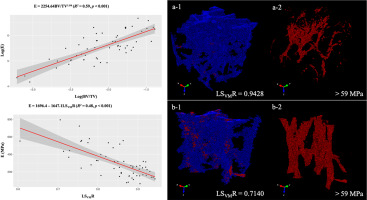Our official English website, www.x-mol.net, welcomes your
feedback! (Note: you will need to create a separate account there.)
A novel mechanical parameter to quantify the microarchitecture effect on apparent modulus of trabecular bone: A computational analysis of ineffective bone mass
Bone ( IF 3.5 ) Pub Date : 2020-06-01 , DOI: 10.1016/j.bone.2020.115314 Yongqiang Jin 1 , Teng Zhang 1 , Jason Pui Yin Cheung 1 , Tak Man Wong 1 , Xiaoreng Feng 1 , Tianhao Sun 2 , Haiyue Zu 3 , Kam Yim Sze 4 , William Weijia Lu 1
Bone ( IF 3.5 ) Pub Date : 2020-06-01 , DOI: 10.1016/j.bone.2020.115314 Yongqiang Jin 1 , Teng Zhang 1 , Jason Pui Yin Cheung 1 , Tak Man Wong 1 , Xiaoreng Feng 1 , Tianhao Sun 2 , Haiyue Zu 3 , Kam Yim Sze 4 , William Weijia Lu 1
Affiliation

|
BACKGROUND
One of the characteristics of osteoporotic bone is the deterioration of trabecular microarchitecture. Previous studies have shown microarchitecture alone can vary the apparent modulus of trabecular bone significantly independent of bone volume fraction (BV/TV) from morphological and topological perspectives. However, the modulus is a mechanical quantity and there is a lack of mechanical explanatory parameter. This study aims to propose a novel mechanical parameter to quantify the microarchitecture effect on the apparent modulus of trabecular bone. MATERIALS AND METHODS
Fourteen human female cadaveric vertebrae were scanned with a dual-energy X-ray (DXA) equipment followed by a micro-CT (μCT) system at 18 μm isotropic resolution. Four trabecular bone specimens (3.46 × 3.46 × 3.46 mm) were obtained from each vertebral body and converted to voxel-based micro finite element (μFE) models. The apparent modulus (E) of the μFE model was computed using linear micro finite element analysis (μFEA). The normalized apparent modulus (E*) was computed as E divided by BV/TV. The relationship between E and BV/TV was analyzed by linear, power-law and exponential regressions. Linear regression was performed between E* and BV/TV. Ineffective bone mass (InBM) was defined as the bone mass with a negligible contribution to the load-resistance and represented by elements with von Mises stress less than a certain stress threshold. InBM was quantified as the low von Mises stress ratio (LSVMR), which is the ratio of the number of InBM elements to the total number of elements in the μFE model. An incremental search technique with coarse and fine search intervals of 10 and 1 MPa, respectively, was adopted to determine the stress threshold for calculating LSVMR of the μFE model. Correlation between E* and LSVMR was analyzed using linear and power-law models for each stress threshold. The threshold producing the highest coefficient of determination (R2) in the correlation between E* and LSVMR was taken as the optimal stress threshold for calculating LSVMR. Linear regression was performed between E and LSVMR. Multiple linear regression of E against both BV/TV and LSVMR was further analyzed. RESULTS
E significantly (p < .001) correlates to BV/TV whereas E* has no significant (p = .75) correlation with BV/TV. Incremental search suggests 59 MPa to be the optimal stress threshold for calculating LSVMR. BV/TV alone can explain 59% of the variation in E using power-law regression model (E = 2254.64BV/TV1.04, R2 = 0.59, p < .001). LSVMR alone can explain 48% of the variation in E using linear regression model (E = 1696.4-1647.1LSVMR, R2 = 0.48, p < .001). With these two predictors taken into consideration, 95% of the variation in E can be explained in a multiple linear regression model (E = 1364.89 + 2184.37BV/TV - 1605.38LSVMR, adjusted R2 = 0.95, p < .001). CONCLUSION
LSVMR can be adopted as the mechanical parameter to quantify the microarchitecture effect on the apparent modulus of trabecular bone.
中文翻译:

量化微结构对小梁骨表观模量影响的新力学参数:无效骨量的计算分析
背景技术骨质疏松骨的特征之一是小梁微结构的退化。先前的研究表明,从形态学和拓扑学的角度来看,单独的微结构可以显着改变骨小梁的表观模量,而与骨体积分数 (BV/TV) 无关。但模量是一个力学量,缺乏力学解释参数。本研究旨在提出一种新的力学参数来量化微结构对小梁骨表观模量的影响。材料和方法 用双能 X 射线 (DXA) 设备和微 CT (μCT) 系统以 18 μm 各向同性分辨率扫描 14 具人类女性尸体椎骨。四个小梁骨标本(3.46 × 3.46 × 3. 46 毫米)从每个椎体获得并转换为基于体素的微有限元 (μFE) 模型。μFE 模型的表观模量 (E) 使用线性微有限元分析 (μFEA) 计算。归一化表观模量 (E*) 计算为 E 除以 BV/TV。E 和 BV/TV 之间的关系通过线性、幂律和指数回归分析。在 E* 和 BV/TV 之间进行线性回归。无效骨量 (InBM) 被定义为对负载阻力的贡献可以忽略不计的骨量,并且由具有小于某个应力阈值的 von Mises 应力的元素表示。InBM 被量化为低 von Mises 应力比 (LSVMR),它是 InBM 元素数量与 μFE 模型中元素总数的比率。采用粗、细搜索间隔分别为 10 和 1 MPa 的增量搜索技术来确定计算 μFE 模型 LSVMR 的应力阈值。对于每个应力阈值,使用线性和幂律模型分析 E* 和 LSVMR 之间的相关性。在 E* 和 LSVMR 之间的相关性中产生最高决定系数 (R2) 的阈值被作为计算 LSVMR 的最佳应力阈值。在 E 和 LSVMR 之间进行线性回归。进一步分析了 E 对 BV/TV 和 LSVMR 的多元线性回归。结果 E 与 BV/TV 显着相关 (p < .001),而 E* 与 BV/TV 没有显着相关性 (p = .75)。增量搜索表明 59 MPa 是计算 LSVMR 的最佳应力阈值。使用幂律回归模型(E = 2254.64BV/TV1.04,R2 = 0.59,p < .001),仅 BV/TV 就可以解释 E 中 59% 的变化。使用线性回归模型(E = 1696.4-1647.1LSVMR,R2 = 0.48,p < .001),仅 LSVMR 就可以解释 E 中 48% 的变化。考虑到这两个预测因子,E 中 95% 的变化可以用多元线性回归模型来解释(E = 1364.89 + 2184.37BV/TV - 1605.38LSVMR,调整后的 R2 = 0.95,p < .001)。结论 LSVMR 可以作为力学参数来量化微结构对骨小梁表观模量的影响。考虑到这两个预测因子,E 中 95% 的变化可以用多元线性回归模型来解释(E = 1364.89 + 2184.37BV/TV - 1605.38LSVMR,调整后的 R2 = 0.95,p < .001)。结论 LSVMR 可以作为力学参数来量化微结构对骨小梁表观模量的影响。考虑到这两个预测因子,E 中 95% 的变化可以用多元线性回归模型来解释(E = 1364.89 + 2184.37BV/TV - 1605.38LSVMR,调整后的 R2 = 0.95,p < .001)。结论 LSVMR 可以作为力学参数来量化微结构对骨小梁表观模量的影响。
更新日期:2020-06-01
中文翻译:

量化微结构对小梁骨表观模量影响的新力学参数:无效骨量的计算分析
背景技术骨质疏松骨的特征之一是小梁微结构的退化。先前的研究表明,从形态学和拓扑学的角度来看,单独的微结构可以显着改变骨小梁的表观模量,而与骨体积分数 (BV/TV) 无关。但模量是一个力学量,缺乏力学解释参数。本研究旨在提出一种新的力学参数来量化微结构对小梁骨表观模量的影响。材料和方法 用双能 X 射线 (DXA) 设备和微 CT (μCT) 系统以 18 μm 各向同性分辨率扫描 14 具人类女性尸体椎骨。四个小梁骨标本(3.46 × 3.46 × 3. 46 毫米)从每个椎体获得并转换为基于体素的微有限元 (μFE) 模型。μFE 模型的表观模量 (E) 使用线性微有限元分析 (μFEA) 计算。归一化表观模量 (E*) 计算为 E 除以 BV/TV。E 和 BV/TV 之间的关系通过线性、幂律和指数回归分析。在 E* 和 BV/TV 之间进行线性回归。无效骨量 (InBM) 被定义为对负载阻力的贡献可以忽略不计的骨量,并且由具有小于某个应力阈值的 von Mises 应力的元素表示。InBM 被量化为低 von Mises 应力比 (LSVMR),它是 InBM 元素数量与 μFE 模型中元素总数的比率。采用粗、细搜索间隔分别为 10 和 1 MPa 的增量搜索技术来确定计算 μFE 模型 LSVMR 的应力阈值。对于每个应力阈值,使用线性和幂律模型分析 E* 和 LSVMR 之间的相关性。在 E* 和 LSVMR 之间的相关性中产生最高决定系数 (R2) 的阈值被作为计算 LSVMR 的最佳应力阈值。在 E 和 LSVMR 之间进行线性回归。进一步分析了 E 对 BV/TV 和 LSVMR 的多元线性回归。结果 E 与 BV/TV 显着相关 (p < .001),而 E* 与 BV/TV 没有显着相关性 (p = .75)。增量搜索表明 59 MPa 是计算 LSVMR 的最佳应力阈值。使用幂律回归模型(E = 2254.64BV/TV1.04,R2 = 0.59,p < .001),仅 BV/TV 就可以解释 E 中 59% 的变化。使用线性回归模型(E = 1696.4-1647.1LSVMR,R2 = 0.48,p < .001),仅 LSVMR 就可以解释 E 中 48% 的变化。考虑到这两个预测因子,E 中 95% 的变化可以用多元线性回归模型来解释(E = 1364.89 + 2184.37BV/TV - 1605.38LSVMR,调整后的 R2 = 0.95,p < .001)。结论 LSVMR 可以作为力学参数来量化微结构对骨小梁表观模量的影响。考虑到这两个预测因子,E 中 95% 的变化可以用多元线性回归模型来解释(E = 1364.89 + 2184.37BV/TV - 1605.38LSVMR,调整后的 R2 = 0.95,p < .001)。结论 LSVMR 可以作为力学参数来量化微结构对骨小梁表观模量的影响。考虑到这两个预测因子,E 中 95% 的变化可以用多元线性回归模型来解释(E = 1364.89 + 2184.37BV/TV - 1605.38LSVMR,调整后的 R2 = 0.95,p < .001)。结论 LSVMR 可以作为力学参数来量化微结构对骨小梁表观模量的影响。











































 京公网安备 11010802027423号
京公网安备 11010802027423号